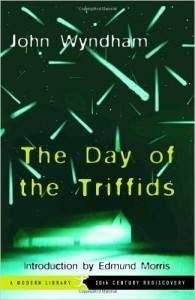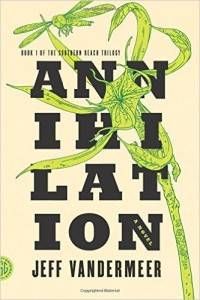I read it as a middle-schooler, after my mother’s boss (a 60-something school librarian who read a book a night) learned that I loved science fiction and started sending grocery bags of mass-market paperbacks home to me. I can’t remember the book’s title. I’ve spent hours online trying to find it. I can tell you the basics, though. The protagonists were a plucky teen who’d stowed away on a spaceship and his delicate girlfriend, who was too good for this universe, too pure. Both of them were pretty much forgettable. But the monster. The monster still haunts me. The monster was a man-eating fungus that had grown in the ship’s ventilation system. It lured victims into its lair by singing, then trapped and sucked the fluids out of them. There was no backstory for the fungus. The author said that its spore must have entered on some space traveler’s boot, and that was that. It wasn’t sentient. It wasn’t out to get humanity. The fungus was just fungus. It was an infestation the crew either hadn’t gotten around to or hadn’t noticed yet. Someone could have taken care of it with a bucket of bleach and a pair of rubber gloves, but no one had gotten around to it, and it started eating people. I’m kind of a casual housekeeper, so that sort of thing scares the hell out of me. Killer plants (and fungi) are scary to me for so many other reasons as well: Unless it’s Audrey II from Little Shop of Horrors, you can’t try to reason with them. Also, there are so many ways a plant or a fungus can invade your body and kill you: it can grow on you, shoot spores into your face, poison you, send vines or roots after you, or chomp down on you if it’s got teeth. Let’s be real here: if a plant decides it wants to kill you, you’re really not safe anywhere. Because I cannot find my original novel to scare you this Halloween, here are some other books about terrifying plants. The Day of the Triffids by John Wyndham The Day of the Triffids is probably the classic killer plant book. Day of the Triffids was written in 1951, but aside from some pretty jarring sexism and ableism, it feels much more contemporary. This might be because the world of Day of the Triffids is familiar to anyone who watches AMC on Sundays. The empty city streets, gangs of survivors, and return to off-the-grid living look exactly like the world of The Walking Dead. (In fact, The Walking Dead even stole Wyndham’s opening scene) Horrifying flora: Triffids are huge walking plants with a sting capable of blinding or killing a human and an ability to get nourishment from a dead body. When most of the human population is blinded by a shower of green comets, the triffids, which are being farmed for oil, bust out of their farms and hunt humanity, driving blind, panicked humans like cattle. Are they out to get us? Oh hell yes they are. Start blindfolding yourself and feeling your way around your house and yard in order to prepare yourself for the inevitable triffid takeover. The Hangman’s Replacement (The Sprout of Disruption) by Taona Dumisani Chiveneko The Sprout of Disruption is the first of a trilogy about a political crisis in Zimbabwe, and follows several storylines. The main thread has to do with a man who is applying to be Zimbabwe’s next hangman, but there are also flowers in this book. That would be lovely, except they eat dead people. Horrifying flora: These Carnivorous flame lilies are genetically modified to eat dead bodies. The first lilies are planted at a national monument, where they cause all kinds of consternation, because Zimbabwe has recently endured both a war and corruption, and none of the people in power want carnivorous flowers growing atop the secret graves of their enemies. The lilies, however, may want more than dead meat. Are they out to get us? Get a grip on yourself, reader. Lilies are just lilies. They’re not out for you. But the person who developed them? S/he is totally coming for you. Annihilation by Jeff VanderMeer In Annihilation, the first in a trilogy, a government-funded expedition makes its way into Area X, an uninhabited area that was once the site of some mysterious event that left wildlife there changed. Many exhibitions have gone there, but not all of them have come back. Annihilation is told from the point of view of a biologist on the expedition; the first-person narration is terrifying in a don’t-open-the-door kind of way, and will make you reconsider walks in the woods, or on the beach. Horrfying flora: I do not even know how to begin to explain it to you. A kind of awful fungus is involved. I really can’t say more than that. Are they out to get us? Yes, and we are woefully unprepared. We humans are constantly coming to terms with the fact that in order to live, we have to kill. A lot of us get around that by not eating meat. Stories about man-eating plants make us acknowledge that herbivores also take life to live. Might we deserve it when plants go rogue and kill us? We might. But there’s not much we can do about it.


